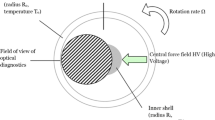Abstract
From the autumn of 2001 till spring of 2005 a series of six flights to the International Space Station, ISS, were conducted using the Russian Soyuz manned launcher. These flights initially known as ‘taxi-missions’, were characterized by the participation and co-funding from both the European Space Agency, ESA, and the five national delegations from France, Italy, Belgium, Spain, and the Netherlands. The national participation was reflected both in the flight of a cosmonaut/astronaut, originating from the country co-sponsoring the flight as well as in the origin of the majority of experiments and other activities carried out during these missions. In these six Soyuz missions: Andromède (October 2001), Marco Polo (April 2002), Odissea (October 2002), Cervantes (October 2003), DELTA (April 2004) and Eneide (April 2005), some more than one hundred experiments were carried out. These experiments covered the areas of basic and applied research and technology in biology, human physiology, fluid and plasma physics, material science and Earth observation. Also a significant number of education activities were part of these missions. This paper gives a complete overview of these missions, of all science, education and related activities performed. The perspectives of these activities in the light of the space exploration programs in the XXI century and some of the uncertainties and paradoxes are discussed.
Similar content being viewed by others
References
Coenegrachts L., Stockmans I., Segers I., Bouillon R. Carmeliet G. The effect of microgravity on 1,25-dihydroxyvitamin D3 signalling in osteoblasts. Microgravity Science and Technology, Issue 19, Vol. 5-6: 154 (2007).
Nusgens, B., Lambert Ch., Lapière Ch.M. Signaling trough Rho GTPases in microgravity (Rho signaling) on the ISS (Soyuz TMA-1) Belgium Soyuz missions ‘Odissea’. Microgravity Science and Technology, Issue 19, Vol. 5-6: 184 (2007).
Herranz R., Laván D.A., Benguría A., Duque P., Leandro L.J., Gasset G., Medina F. J., van Loon J., R. Marco. The “Gene” Experiment in the Spanish Soyuz Mission to the ISS. Effects of the cold transportation step. Microgravity Science and Technology, Issue 19, Vol. 5-6: 196 (2007).
Matía I., González-Camacho F., Marco R., Kiss J.Z., Gasset G., van Loon J., Medina F.J. The “Root” experiment of the “Cervantes” Spanish Soyuz Mission: Cell proliferation and nucleolar activity alterations in Arabidopsis roots germinated in real or simulated microgravity. Microgravity Science and Technology, Issue 19, Vol. 5-6: 128 (2007).
H.P. Willemsen, E. Langerak.Hardware for biological microgravity experiments in Soyuz missions. Microgravity Science and Technology, Issue 19, Vol. 5-6: 75 (2007).
Maes D., Decanniere K., Zegers I., Vanhee C., Sleutel M., Willaert R., Van De Weerdt C., Martial J., Declercq J-P., Evrard C., Otalora F. Garcia-Ruiz J. Protein crystallisation under microgravity conditions: What did we learn on TIM crystallisation from the Soyuz missions? Microgravity Science and Technology, Issue 19, Vol. 5-6: 90 (2007).
Kroesen G., Haverlag M., Dekkers E. et al. ARGES: Radial Segregation and Helical Instabilities in Metal Halide Lamps Studied Under Microgravity Conditions in the International Space Station. Microgravity sci. Technol. XVI-1, 191–195 (2005).
Mesland, D.,Accensi, A.,Alfermann, C,Bennett, J.,Chin, D.,Foeng, A.,Franz, A.,Gesta-Fernandez, J.,Goldzahl, N.,Helmke, H.,Ives, J.,Kruit, A.,Soons, A.,Burden, D., andMillican, S., “The Biorack Facility and its performance during the D1 spacelab mission,” ESA publication SP-1091, 9–26 (1987).
Van Loon J.J.W.A.. BioPack: The ground controlled late access biological research facility. J. Grav. Phys. 11(1), 57–65 (2004).
Florin, G., Broxvall, M., Holm, P., Lundin, M., Löth, K., & Törnqvist, M. The MASER-10 microgravity rocket flight. 17th ESA Symp. European Rocket and Balloon Programmes and Related Research, 30 May - 2 June 2005, Sandefjord, Norway. Ed.: Barbara Warmbein. ESA SP-590, Noordwijk: ESA Publications Division, 531 -536 (2005).
Demets, R.: Experiments on Bion 8 and Bion 9. Edt. Guyenne, T.-D. European Space Agency, ESA SP-1190, (1996).
Van Loon J.J.W.A., Folgering E.H.T.E., Bouten C.V.C., Smit T.H. Centrifuges and inertial shear forces. J. Grav. Phys. 29–38, 11(1) (2004).
Lawler, A. 2008 U.S. Budget: NASA Tries to Make Space for Science. Science 315, 751 (2007).
Lawler, A. Earth to NASA. Science. 316, 1829 (2007).
Author information
Authors and Affiliations
Corresponding author
Rights and permissions
About this article
Cite this article
van Loon, J.J.W.A., Medina, F.J., Stenuit, H. et al. The national — esa soyuz missions andromède, marco polo, odissea, cervantes, delta and eneide. Microgravity Sci. Technol 19, 9–32 (2007). https://doi.org/10.1007/BF02919448
Issue Date:
DOI: https://doi.org/10.1007/BF02919448




